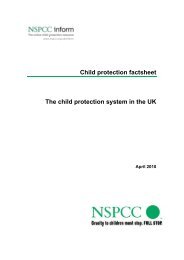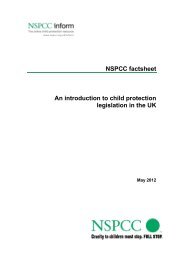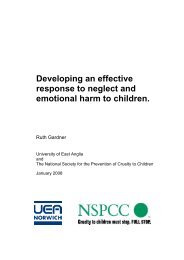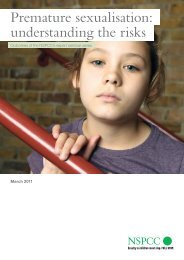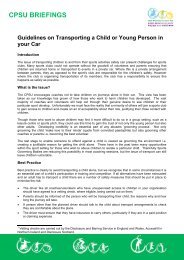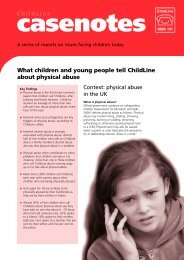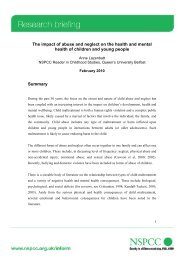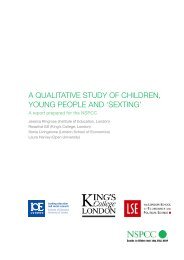Neglect and serious case reviews (PDF, 735KB) - nspcc
Neglect and serious case reviews (PDF, 735KB) - nspcc
Neglect and serious case reviews (PDF, 735KB) - nspcc
You also want an ePaper? Increase the reach of your titles
YUMPU automatically turns print PDFs into web optimized ePapers that Google loves.
<strong>Neglect</strong> <strong>and</strong> Serious Case Reviews<br />
72<br />
agency involvement:<br />
learning:<br />
is a characteristic response to the kind of caregiving that he experienced<br />
over many years. In addition, his early adverse experiences are likely to have<br />
increased his sensitivity to stress leaving him vulnerable to stress related<br />
psychiatric disorders, self harm <strong>and</strong> suicidal ideation (Howe 2005: 163). Discharging<br />
Frazer home to his mother’s care catapulted him into danger as he<br />
was reminded that he was unwanted <strong>and</strong> bad <strong>and</strong> this left him unable to<br />
cope with the feelings this evoked. His mother was also helpless to contain<br />
his powerful <strong>and</strong> self destructive urges.<br />
Children’s social care were involved with Frazer’s family on <strong>and</strong> off from<br />
the time of his birth. He had a child protection plan intermittently between<br />
the ages of five <strong>and</strong> nine (in the categories of neglect <strong>and</strong> physical injury).<br />
He was accommodated at the age of 13 <strong>and</strong> later made the subject of a<br />
care order. From the age of eleven he was known to Child <strong>and</strong> Adolescent<br />
Mental Health Services <strong>and</strong> from age 14 to the youth offending service. He<br />
was assessed as ‘not mentally ill with no real suicidal intent’ numerous times.<br />
Themes emerging from the <strong>serious</strong> <strong>case</strong> <strong>reviews</strong> included:<br />
• young people who are hard to help: Frazer will have transferred<br />
his un successful coping strategies from home to his placements. Those<br />
helping him interpreted his behaviour as sabotaging attempts to contain<br />
him <strong>and</strong> offer safe <strong>and</strong> trusting relationships. Good quality support<br />
<strong>and</strong> training for his carers might have helped them to underst<strong>and</strong> the<br />
complexities of his behaviour <strong>and</strong> how helpless <strong>and</strong> angry Frazer made<br />
them feel. Strategies for dealing with <strong>and</strong> anticipating his behaviour <strong>and</strong><br />
underst<strong>and</strong>ing why he could not trust anyone but himself, might have<br />
helped them to stick with him for longer <strong>and</strong> perhaps reduce Frazer’s<br />
need to run away.<br />
• the danger of return home. Although it may be the worst place for<br />
them, many young people in transition, like Frazer, feel compelled to go<br />
back home <strong>and</strong> will push for it relentlessly. Once back home Frazer <strong>and</strong><br />
his mother needed a high level, intensive support not a low level service.




